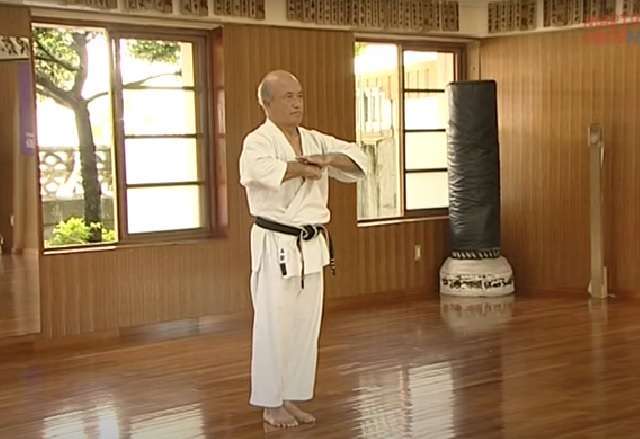Wanshu, a Kata practiced in many martial arts styles, is a great Kata, with a long history. Wanshu is one of the most popular Kata among Okinawan karate systems. The name Wanshu in Mandarin means “Excellent Wrist” and refers to a typical technique of this form. Another translation of the word “Wanshu” is “dumping form,” “dragon boy dumping form,” and “Strong Arm Form” for the dramatic grab-and-throw technique seen in most versions.

Wanshu contains rising punches, numerous level changes, open hand blocks, and a spectacular throw sequence near the end of the Kata. Trying to combine power with the rapid changes of direction is difficult, but the Kata has a very strong rhythm that helps you develop power alongside the quick movements. The techniques are ingeniously designed to complement each other, and this produces a natural fluidity that makes Wanshu a pleasure to practice.
This Kata is also practiced in various Korean styles such as Tang Soo Do and Soo Bahk Do; depending on the organization, it is called Wangshu, Wang Shu, or Yun Bi in Korean. Due to its difficulty, this Kata is often reserved for advanced students.
The origin and creation of Kata Wanshu (also known as Empi in Shotokan Karate), can be shrouded in historical mystery and legends.
While the exact origins of Wanshu may never be definitively proven, there are several hypotheses and theories about the emergence:
Theory 1:
The name Wanshū (腕秀) in Mandarin holds a dual meaning. It can be interpreted as “Excellent Wrist,” alluding to a specific technique within the Kata. Another writing of the Kata’s name (汪輯) signifies “Wang’s Series (or Form),” in reference to the diplomat Wang (1621 – 1689). Wang played a significant role as the leader of a substantial ambassadorial mission dispatched by the Qing government of China in 1683 to the village of Tomari. Wang was a multifaceted individual, encompassing talents in poetry, calligraphy, diplomacy, and martial arts.
The Wanshū Kata’s origins are intertwined with Wang’s legacy. It is believed to have been either created by Wang himself or composed by his students in homage to his teachings and influence.
Theory 2:
An alternative hypothesis posits that the Kata Wanshu may have been introduced by the 36 families from the Min region who were dispatched to the Ryukyu Islands by orders of the Ming Chinese Emperor. These families originally hailed from the Min region of Fujian Province in southern China.
The Min families are believed to have potentially influenced Okinawan martial arts, although there is currently no historical evidence to support this claim. However, it is generally acknowledged that they introduced some form of martial art.
Theory 3:
Report on King Shō Hō’s 1634 Envoy: Prince Kin Ōji Chōtei.
In the annals of history, the year 1634 witnessed a significant event involving King Shō Hō of Ryūkyū, who dispatched Prince Kin Ōji Chōtei to Edo, Japan. This envoy’s mission was marked by gratitude for a momentous occasion-the Japanese enthronement. What makes this historical account intriguing is the translational nuance surrounding the prince’s title “Ōji,” which was recorded as “Wansu.”
Historical Context.
- In 1634, King Shō Hō, the ruler of the Ryūkyū Kingdom, decided to send a special envoy to the Japanese capital of Edo.
- The purpose of this envoy was to express gratitude on behalf of Ryūkyū for a significant event in Japanese history, possibly the enthronement of a new emperor.
The Envoy: Prince Kin Ōji Chōtei.
- Prince Kin Ōji Chōtei was chosen for this diplomatic mission, signifying the importance and goodwill of the mission.
Translational Variation.
- One intriguing aspect of this historical account is the variation in the title “Ōji,” which was rendered as “Wansu” in the records of the time.
- This translational nuance underscores the challenges and intricacies of recording historical events, particularly when titles and names cross linguistic and cultural boundaries.
The variation in the title “Ōji,” as recorded as “Wansu,” serves as a reminder of the complexities of historical documentation and the nuances that can emerge in the interpretation of titles and names.
Now, adding an intriguing twist to the narrative, there are researchers who propose a fascinating connection. They suggest that the title in question might actually be a reference to the Kata name Wanshū. It is simply the title of “prince”.
Comments About the Title “Ōji” and “Ōji (Wansu)”.
The title “Ōji” is associated with royal status as a prince, a common designation in various monarchies, including the Ryukyu Kingdom, indicating a direct familial connection to the reigning monarch.
However, a similar term, “Ōji (Wansu),” shares its written form but has a different meaning within Ryukyuan society. It is suggested to denote a specific rank or title within the noble Pechin class rather than implying royal lineage. This similarity in writing can lead to confusion, despite the distinct implications of each term within the specific context of Ryukyuan society.
Let’s end this article with a wild story.
“Now, as we delve into a world of speculation, let’s embark on an intriguing journey. Nestled between Henan and Fujian provinces lies a lesser-known gem, a small town by the name of Hónghú. Consider this intriguing possibility: What if a martial artist from this obscure town ventured all the way to Okinawa, carrying with them the essence of the Kata we know as Wanshu?”
Could it be that the very name of the Kata was an homage to the person who hailed from the city of Hónghú? Phonetics plays a significant role in our understanding of how words are pronounced and heard. It could be that the citizens of Ryūkyū just did not hear the word Hónghú right, and they started to pronounce it Wanshu instead. This hypothesis paints a vivid picture of a geographical connection, where the roots of the Wanshu Kata might just be intertwined with the distant town of Hónghú in China.
No, just kidding
…. or am I?
Thank you for taking the time to read my article.
Gert
